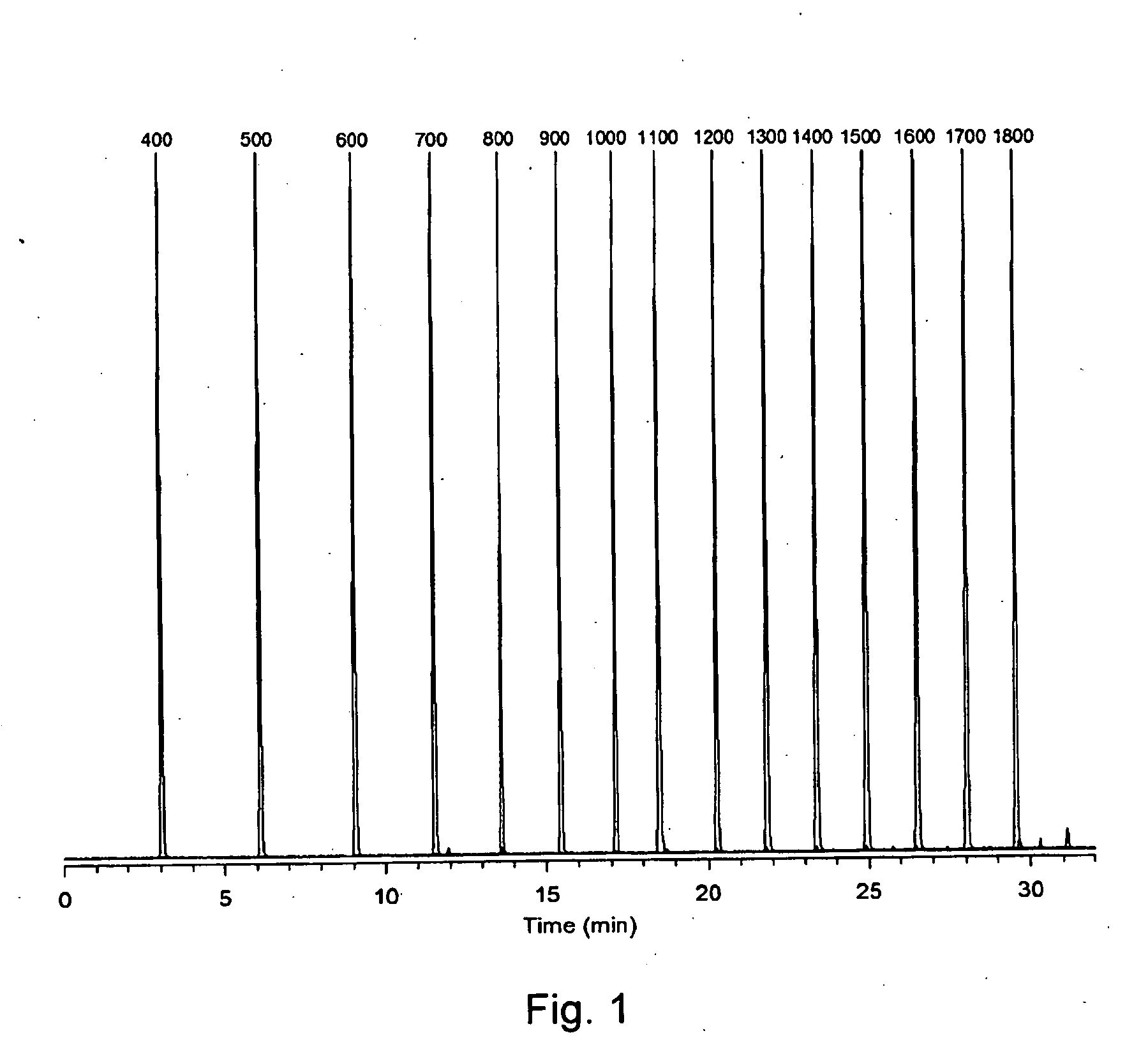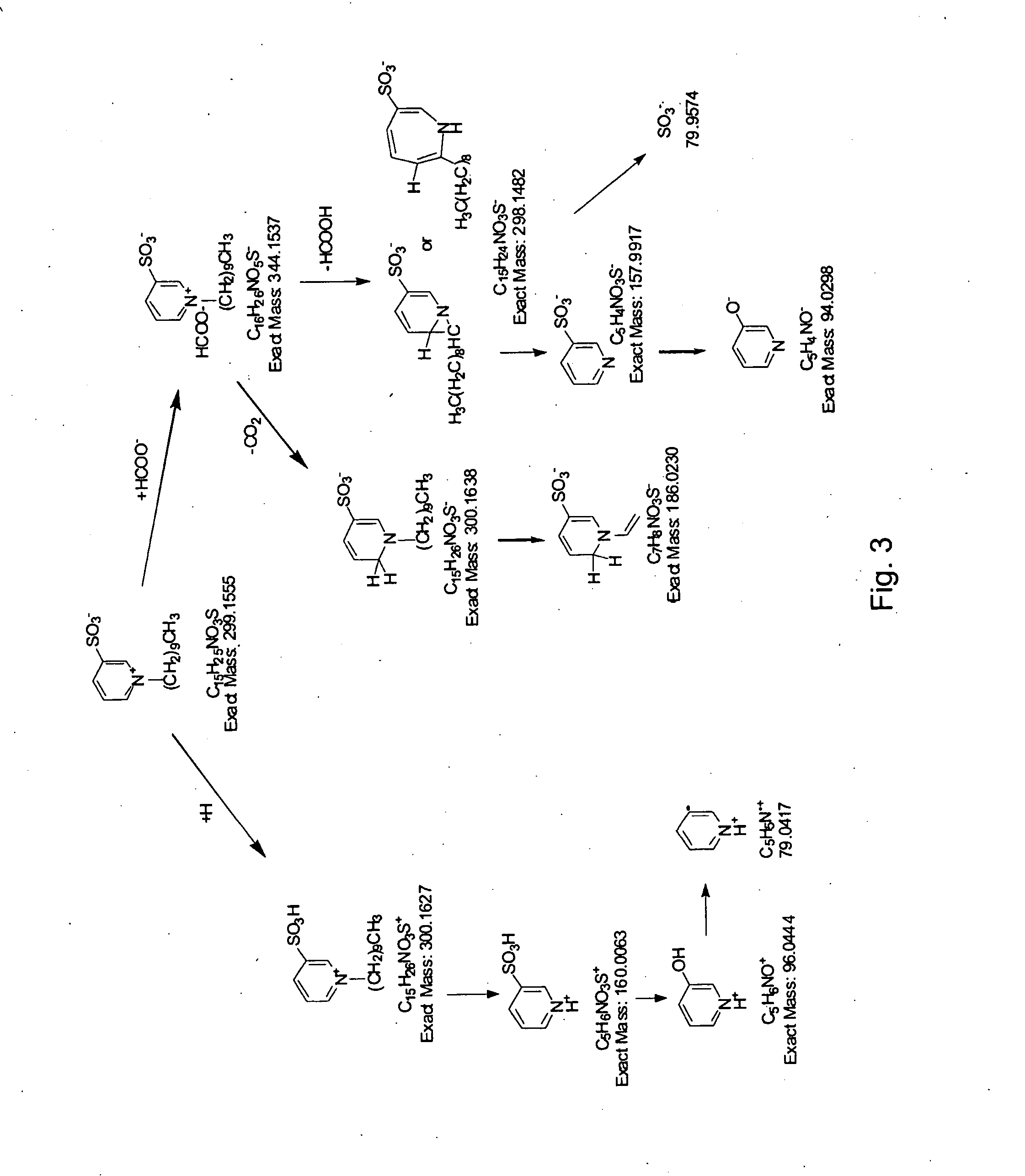Retention index standards for liquid chromatography
a technology of liquid chromatography and retention index, which is applied in the field of analytical chemistry, can solve the problems of increasing the workload of analysts and the cost of analyses, not every laboratory can stock all standards, and analysts in this field face a difficult problem of determining which biotoxin analogues might be present, so as to facilitate the establishment of retention windows and good spread of retention times
- Summary
- Abstract
- Description
- Claims
- Application Information
AI Technical Summary
Benefits of technology
Problems solved by technology
Method used
Image
Examples
example 1
Use of APSA Retention Index Standards to Identify Microcystins by LC-MS
[0041]A sample of cyanobacterial extract containing analytes of Interest (i.e. microcystins) was co-injected with a mixture of the C4-C18 APSA standards into a reversed phase liquid chromatography-mass spectrometry system. The system comprises an LC-ESI-QqQ (QTRAP 4000) instrument with an Agilent 2.7 μm-Poroshell 120 Å SB-C18 column (2.1 x 150 mm). Elution conditions comprise mobile phase: A=water, B=MeCN / water (95:5), both with 50 mM formic acid+2 mM ammonium hydroxide at pH 2.2; with a gradient of 25-75% B over 30 min at a hold time of 5 min, flow rate of 0.25 ml / min, and column temperature of 40° C. The liquid chromatography (LC) column provides separation of the complex mixture while the mass spectrometer provides detection of both the microcystins within the sample and the co-injected APSA standards (FIG. 4). The characteristic mass spectral signals and the retention times of the microcystins and APSAs in th...
example 2
Use of APSA Retention Index Standards to Establish a Database of Retention Indices of Analytes for LC-MS
[0045]A solution containing various reference compounds (i.e. drugs that have been used in agriculture and aquaculture and that are routinely monitored by food inspection agencies) is co-injected along with a mixture of the C4-C18 APSA standards into a reversed phase liquid chromatography-mass spectrometry system. The system comprises an LC-ESI-QqQ (QTRAP 4000) instrument with an Agilent 2.7 μm-Poroshell 120 Å SB-C18 column (2.1 x 150 mm). Elution conditions comprise mobile phase: A=water, B=MeCN / water (95:5), both with, 50 mM formic acid+5 mM ammonium hydroxide at pH 2.2; with a gradient of 5-100% B over 30 min at a hold time of 5 min, flow rate of 0.25 ml / min, and column temperature of 35° C. The liquid chromatography (LC) column provides separation of the complex mixture while the mass spectrometer provides detection of both the reference compounds and the co-injected APSA stan...
example 3
Use of APSA Retention Index Standards to Predict Retention Times for Analytes in order to Establish Windows for Scheduled SRM Analysis by LC-MS
[0047]A database of retention indices for reference compounds (e.g., Table 2) is used to predict retention times of the same compounds that are to be run on columns with different dimensions, possibly with using various gradient conditions or different LC instruments. This can facilitate the establishment of retention windows of targeted analytes in order to permit the programming of a scheduled selected reaction monitoring method. The process involves first performing an analysis of a mixture of the APSA retention Index standards under the LC conditions and on the column and instrument to be used for samples. Interpolation of the database retention indices for reference compounds Into a plot of the retention times vs. retention index values for APSA standards would allow the calculation of retention times expected under those new conditions....
PUM
| Property | Measurement | Unit |
|---|---|---|
| length | aaaaa | aaaaa |
| temperature | aaaaa | aaaaa |
| temperature | aaaaa | aaaaa |
Abstract
Description
Claims
Application Information
 Login to View More
Login to View More - R&D
- Intellectual Property
- Life Sciences
- Materials
- Tech Scout
- Unparalleled Data Quality
- Higher Quality Content
- 60% Fewer Hallucinations
Browse by: Latest US Patents, China's latest patents, Technical Efficacy Thesaurus, Application Domain, Technology Topic, Popular Technical Reports.
© 2025 PatSnap. All rights reserved.Legal|Privacy policy|Modern Slavery Act Transparency Statement|Sitemap|About US| Contact US: help@patsnap.com



